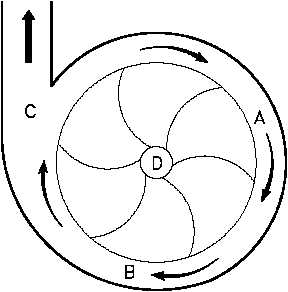AIR COMPRESSORS
DOE-HDBK-1018/2-93
Miscellaneous Mechanical Components
Centrifugal Compressors
Figure 6 Simplified Centrifugal Pump
The centrifugal compressor, originally
built to handle only large volumes of low
pressure gas and air (maximum of 40
psig), has been developed to enable it to
move large volumes of gas with discharge
pressures up to 3,500 psig. However,
centrifugal compressors are now most
frequently used for medium volume and
medium pressure air delivery.
One
advantage of a centrifugal pump is the
smooth discharge of the compressed air.
The centrifugal force utilized by the
centrifugal compressor is the same force
utilized by the centrifugal pump. The air
particles enter the eye of the impeller,
designated D in Figure 6.
As the
impeller rotates, air is thrown against the
casing of the compressor.
The air
becomes compressed as more and more air is thrown out to the casing by the impeller blades.
The air is pushed along the path designated A, B, and C in Figure 6. The pressure of the air
is increased as it is pushed along this path. Note in Figure 6 that the impeller blades curve
forward, which is opposite to the backward curve used in typical centrifugal liquid pumps.
Centrifugal compressors can use a variety of blade orientation including both forward and
backward curves as well as other designs.
There may be several stages to a centrifugal air compressor, as in the centrifugal pump, and the
result would be the same; a higher pressure would be produced. The air compressor is used to
create compressed or high pressure air for a variety of uses. Some of its uses are pneumatic
control devices, pneumatic sensors, pneumatic valve operators, pneumatic motors, and starting
air for diesel engines.
Compressor Coolers
The amount of moisture that air can hold is inversely proportional to the pressure of the air. As
the pressure of the air increases, the amount of moisture that air can hold decreases. The amount
of moisture that air can hold is also proportional to the temperature of the air. As the
temperature of the air increases, the amount of moisture it can hold increases. However, the
pressure change of compressed air is larger than the temperature change of the compressed air.
This causes the moisture in the air to condense. Moisture in compressed air systems can cause
serious damage. The condensed moisture can cause corrosion, water hammers, and freeze
damage; therefore, it is important to avoid moisture in compressed air systems. Coolers are used
to minimize the problems caused by heat and moisture in compressed air systems.
ME-05
Rev. 0
Page 6



